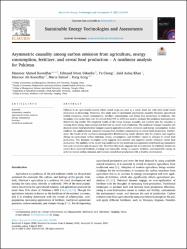| dc.contributor.author | Koondhar, Mansoor Ahmed | |
| dc.contributor.author | Udemba, Edmund Ntom | |
| dc.contributor.author | Cheng, Ya | |
| dc.contributor.author | Khan, Zaid Ashiq | |
| dc.contributor.author | Koondhar, Masroor Ali | |
| dc.contributor.author | Batool, Maria | |
| dc.contributor.author | Kong, Rong | |
| dc.date.accessioned | 2023-07-06T19:52:41Z | |
| dc.date.available | 2023-07-06T19:52:41Z | |
| dc.date.issued | 2021 | en_US |
| dc.identifier.issn | 2213-1388 | |
| dc.identifier.issn | 2213-1396 | |
| dc.identifier.uri | https://hdl.handle.net/11363/4960 | |
| dc.description.abstract | Pakistan is an agricultural country where cereal crops are used as a staple food, but with time trend cereal
production is decreasing. Therefore, this study aims to investigate asymmetric causality between agricultural
carbon emissions, energy consumption, fertilizer consumption, and cereal food production in Pakistan. The
secondary time series data over the period from1976 to 2018 was used to estimate the nonlinear-autoregressive
distributed lag model. The empirical results of the linear Granger causality test confirm that the causality is
running from energy consumption and fertilizer to cereal food production. The nonlinear Granger causality test
declares cereal food production Granger cause to agricultural carbon emissions and energy consumption. It also
confirms the unidirectional causality running from fertilizer consumption to cereal food production. Furthermore, the results of the nonlinear-autoregressive distributed lag model disclose that the positive and negative
change in agricultural carbon emission, energy consumption, and fertilizer causes to changes in cereal food
production. The dynamic multiplier curve suggests that positive and negative shocks influence cereal food
production. The stability of the model was confirmed by the nonlinear-autoregressive distributed lag cumulative
sum and cumulative sum of square test. Therefore this study suggests that it is essential for Pakistani farmers to
switch from chemical fertilizer, burning non-renewable energy to organic fertilizer, and renewable energy in
order to reduce carbon emission and increase cereal food production with a healthy environment. | en_US |
| dc.language.iso | eng | en_US |
| dc.publisher | ELSEVIER, RADARWEG 29, 1043 NX AMSTERDAM, NETHERLANDS | en_US |
| dc.relation.isversionof | 10.1016/j.seta.2021.101099 | en_US |
| dc.rights | info:eu-repo/semantics/openAccess | en_US |
| dc.rights | Attribution-NonCommercial-NoDerivs 3.0 United States | * |
| dc.rights.uri | http://creativecommons.org/licenses/by-nc-nd/3.0/us/ | * |
| dc.subject | Asymmetric causality | en_US |
| dc.subject | Agricultural carbon emission | en_US |
| dc.subject | Energy consumption | en_US |
| dc.subject | Fertilizer | en_US |
| dc.subject | Cereal food production | en_US |
| dc.title | Asymmetric causality among carbon emission from agriculture, energy consumption, fertilizer, and cereal food production - A nonlinear analysis for Pakistan | en_US |
| dc.type | article | en_US |
| dc.relation.ispartof | Sustainable Energy Technologies and Assessments | en_US |
| dc.department | İktisadi İdari ve Sosyal Bilimler Fakültesi | en_US |
| dc.authorid | https://orcid.org/0000-0003-3470-5837 | en_US |
| dc.identifier.volume | 45 | en_US |
| dc.identifier.startpage | 1 | en_US |
| dc.identifier.endpage | 11 | en_US |
| dc.relation.publicationcategory | Makale - Uluslararası Hakemli Dergi - Kurum Öğretim Elemanı | en_US |
| dc.institutionauthor | Udemba, Edmund Ntom | |



















